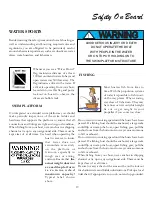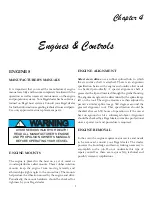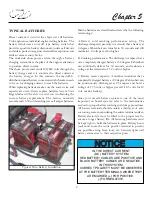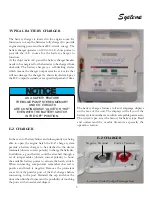
ENGINE VENTILATION
Ventilation systems are required for gasoline engine
compartments. Your boat features a set of deck vent
shrouds which supply a consistant amount of air to the
engine compartment. Powered blower motors connected
to ducts in the lower one third of the bilge evacuate
contaminated air to the atmosphere. Understand the
following warning!
It is important that you read the propulsion manufacturer’s
manual carefully and become familiar with the operation
as well as necessary maintenance on the drive train
components. Pay careful attention to the sections on
winterization if you live in freezing climates. Extensive
damage can result if proper winterization is not followed.
Refer to the maintenance section of this manual for more
information or call your nearest Regal dealer.
AUDIBLE ALARMS
Selected engines use audible alarms. They are designed to
use sensors which pick up deviations from the normal
operating parameters. Oil pressure and temperature sensors
send a signal to a buzzer under the dash which sounds a
high pitched alarm indicating a possible problem. In
addition to the dash, some engines use buzzers at the engine
itself. On start up it is not unusual to hear an audible alarm
sound when cranking the engine over. This occurs normally
because it takes a second or two to build up the engine oil
pressure. Then the alarm will stop.
A seasoned skipper monitors his instrument panel often
while cruising.
TO PREVENT INJURY OR DEATH
USE ONLY APPROVED MARINE
REPLACEMENT PARTS
THAT ARE IGNITION PROTECTED.
WARNING
!
PROPULSION
STERN DRIVES
Check the intake and exhaust (ducts) vents periodically
for debris build up. They are located on both aft sides of
the deck. See photo. When in the bilge make sure you do
not step on the black bilge blower hoses.
Ensure that the hose runs are sloped at a constant down-
ward angle to prevent any water trapping.
INTAKE & EXHAUST VENTILATION
DUCTS
WARNING
!
GASOLINE VAPORS CAN EXPLODE!
BEFORE STARTING ENGINE(S)
OPERATE BLOWER(S) 4 MINUTES
AND CHECK ENGINE COMPARTMENT FOR
GASOLINE LEAKS AND VAPORS.
RUN BLOWER(S) BELOW CRUSING SPEEDS.
2
Chapter 4
TYPICAL VENTILATION DUCT
Summary of Contents for 30 EXPRESS
Page 1: ...30 EXPRESS OWNER S MANUAL...
Page 2: ...784022 OWNER S MANUAL 30 EXPRESS 12 2012...
Page 30: ...11 Safety On Board NAVIGATION LIGHT RULES...
Page 41: ...Chapter 2 22 Notes...
Page 44: ...3 Rules Of The Road NAVIGATION RULES...
Page 85: ...28 Chapter 5 Notes...
Page 105: ...4 Chapter 7...
Page 106: ...5 Equipment Operation...
Page 107: ...6 Chapter 7...
Page 108: ...7 Equipment Operation...
Page 109: ...8 Chapter 7...
Page 110: ...9 Equipment Operation...
Page 111: ...10 Chapter 7...
Page 117: ...16 Chapter 7...
Page 126: ...25 Equipment Operation ROTARY ENCODER AND MENU KEY...
Page 127: ...26 Chapter 7 USING THE ROTARY ENCODER AND MENU KEY...
Page 158: ...57 Equipment Operation BACKING A TRAILER 1 2 3 4 LAUNCHING RAMP...
Page 161: ...60 Chapter 7 Notes...
Page 195: ...34 Chapter 8 Notes...
Page 204: ...9 Troubleshooting TOILET SYSTEM DIAGNOSTIC CHART...
Page 209: ...14 Chapter 9...
Page 219: ...6 Chapter 11 Notes...
Page 221: ...2 Chapter 12...
Page 224: ...5 Technical Information 30 Express Deck Overview 30 Express Cabin Overview...
Page 225: ...Technical Information 12 6 30 EXPRESS...
Page 226: ...12 7 Technical Information 30 EXPRESS...
Page 227: ...Technical Information 12 8 30 EXPRESS...
Page 228: ...12 9 Technical Information 30 EXPRESS...
Page 229: ...Technical Information 12 10 30 EXPRESS 30 EXPRESS...
Page 230: ...12 11 Technical Information TYPICAL NEGATIVE GROUND SYSTEM...
Page 231: ...Technical Information 12 12 30 EXPRESS...
Page 232: ...12 13 Technical Information 30 EXPRESS...
















































